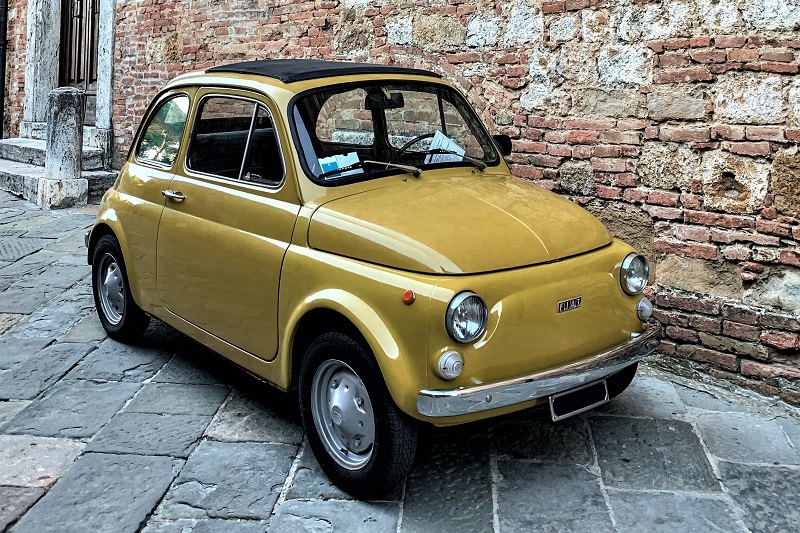Overview
The Fiat 500, a car that has become a symbol of Italian style and design, is one of the most iconic vehicles ever produced. From its humble beginnings in the post-war years to its modern reincarnation as a chic urban runabout, the Fiat 500 has always been a car that captures the imagination. Its compact dimensions, charming looks and fun-to-drive nature have endeared it to motorists worldwide. But how did this diminutive Italian classic come to be? To answer that question, we need to delve into its rich history.

The Birth of a Motoring Classic
The story of the Fiat 500 begins in the aftermath of World War II. Italy, like many other European nations, was devastated by the war. The country needed a cheap, reliable form of transport for its rapidly urbanizing population. It also needed a hardy compact car for the narrow, cobble-stoned streets Italy’s so famous for. Fiat, Italy’s largest car manufacturer, rose to the challenge and in 1957, released the original Fiat 500. Designed by legendary Italian engineer Dante Giacosa, the Fiat 500 was a masterstroke of automotive design. Despite its tiny size, it could comfortably seat two adults and two children. Its air-cooled, rear-mounted engine was simple and reliable, and its small proportions made it perfect for navigating the narrow, congested streets of Italian cities. It was a car designed for the people, and the people loved it. During its 18-year production run, Fiat produced more than 3.8 million 500s.

The Evolution of the Classic Fiat 500 Design
The Fiat 500’s design has evolved significantly over the years. The original model, known as the “Nuova” (meaning ‘new’), was characterized by its distinctive round headlights and “suicide” front-hinged doors. In 1965, Fiat introduced the 500F, which featured conventional rear-hinged doors and a more modern dashboard. This was followed by the 500L, or Lusso, which boasted a more luxurious interior and exterior chrome trim.
In 2007, Fiat launched a new, modern interpretation of the 500. While compact by today’s standards, it was significantly larger than its predecessor, but it retained many of the original’s design cues, such as the round headlights, the clam shell bonnet and the distinctive ‘whiskers and logo’ front fascia. The new Fiat 500 was an instant hit, winning numerous design awards and sparking a retro car trend that continues to this day.

Fiat 500 in Pop Culture
The Fiat 500’s iconic status has seen Hollywood stars like Audrey Hepburn and Charlize Theron drive it on-screen, and it has appeared in numerous films and TV shows, from the romantic comedy ‘Roman Holiday’, the atmospheric ‘The Big Blue’, to the action-packed ‘The Italian Job’ and 1986’s ‘Detective School Dropouts’. Tom Cruise drives the latest Fiat 500e in the 7th ‘Mission Impossible’ film installment due out in 2023, and both old and new models feature as playful cars in the animated movie ‘Cars 2’.
Its playful, cheeky image has endeared it to artists and musicians, and it has even been immortalized in the lyrics of popular songs. Smokstik released a single called ‘The 500 Song (The Abarth Rocks)’ in 2016, and collaborators Sting and Shaggy starred in an advert in 2019 for the Fiat 500 Star and Fiat 500 Rockstar with their reggae-inspired single ‘Just One Lifetime’.
However, Fiat 500’s popularity extends beyond the silver screen and the music charts. It has been the subject of countless artworks, from pop art prints to intricate scale models. It has inspired fashion collections, homewares, and even a line of Fiat 500-branded merchandise. Its enduring appeal is a testament to its design and the joy it brings to its owners and admirers.

Key Milestones and Generations of the Fiat 500
The first generation called the Nuova, was produced from 1957 to 1975. It was re-imagined 32 years later from 2007 through to 2020 due to the popularity of other motoring classics that had a new lease on life – namely the Mini and the Volkswagen Beetle. The third generation, launched in 2020, marked the model’s transition to electric power. Each generation of the Fiat 500 has brought with it significant advancements, from the introduction of a semi-automatic transmission in the 1960s to the addition of advanced safety features and connectivity technology in the modern era. However, throughout its history, the Fiat 500 has always remained true to its roots as a stylish, compact fun-to-drive city car.
Special Editions and Collaborations of the Fiat 500
Over the years, Fiat has released numerous special editions and collaborations of the 500. These have ranged from high-performance, expensive hot-hatch Abarth models to luxury versions co-created with fashion houses like Gucci and Diesel. There have also been numerous concept cars, such as the beach-ready 500 Spiaggina and the all-electric 500e. These special editions and collaborations have often pushed the boundaries of what is possible with the 500’s compact platform. They have showcased Fiat’s innovative spirit and willingness to experiment, and they have helped to keep the 500 fresh and exciting throughout its long and storied history.

The Future of Fiat 500: Electric and Sustainable Motoring
The future of the Fiat 500 is electric. In 2020, Fiat launched the third-generation 500, which is the first model in the 500’s history to be powered solely by electricity. With a range of up to 199 miles on a single charge and a host of advanced features, the new 500 is at the forefront of the electric vehicle revolution – even if it does come at a price. But Fiat’s commitment to sustainable motoring goes beyond just electric power. The company is also exploring other eco-friendly technologies, such as bio-fuels and hybrid powertrains. Furthermore, Fiat is committed to reducing its environmental impact through sustainable manufacturing practices and recycling programs.
Collecting and Maintaining the Classic Fiat 500
Collecting and maintaining a classic Fiat 500 can be a rewarding experience, but it also comes with its challenges. Common problems to look out for when owning a Fiat 500 include rust, electrical issues, and engine problems. However, with regular maintenance and care, these issues can be kept in check. For those considering buying a classic Fiat 500, it’s important to do your homework.
Research the car’s history, get it inspected by a professional, and be prepared for the possible costs of restoration and maintenance. Also, consider joining a Fiat 500 owners’ club, where you can share experiences and advice with other enthusiasts.
Conclusion
The Fiat 500’s Continued Influence on Motoring The Fiat 500’s influence on motoring is undeniable. It has set the standard for small, stylish city cars and has inspired countless imitators. Its design, performance, and personality have made it a favorite among motorists, collectors, and enthusiasts alike. As we look to the future, it is clear that the Fiat 500 will continue to play a leading role in the evolution of the automobile. The Fiat 500’s story is far from over, and we can’t wait to see what the next chapter holds.

